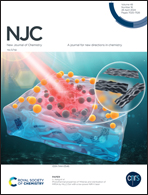Investigating drug abuse in hair samples using the electrospun PEDOT–CNT nanostructure along with EA-IT-SPME†
Abstract
Electrospinning, a simple and low-cost method, is one of the best ways to produce nanoscale porous adsorbents. However, electrospinning of pure conductive polymers is not convenient due to their low molecular weight, insolubility in common solvents and the low viscosity of their electrospinning solutions. In this work, electrospinning of a conducting polymer to produce the poly(3,4-ethylene dioxythiophene)–carbon nanotube (PEDOT–CNT) nanostructure was successfully performed using chemical polymerization of the conductive polymer on a skeleton of polyacrylonitrile (PAN). In the next step, the carrier polymer, PAN, was removed so that it did not affect the conductivity of the final product. Conductivity, a surface filled with various functional groups, excellent stability and reusability of PEDOT–CNT make it a good choice for electrically assisted in-tube solid phase microextraction (EA-IT-SPME) analysis of drug abuse in hair samples. Applying the electrical potential increases the extraction efficiency and reduces the extraction time and the volume of desorption organic solvent. The properties of the produced nanocomposite were studied by field emission-scanning electron microscopy, energy dispersive X-ray spectroscopy, and Fourier transform infrared spectroscopy. Different influential parameters of the extraction efficiency, such as adsorption potential, time, flow rate, pH, and ionic strength and potential, type, volume and flow rate of desorption eluent, were optimized. Under optimized conditions, the broad linearity of drugs in both water and hair matrices was in the range of 1.0–1000.0 μg L−1, with coefficients of determination being more than 0.9922. The limit of detection was 0.3 μg L−1 for both media. This method demonstrated appropriate inter- and intra-day precisions (RSDs, n = 3) in the ranges of 2.0–3.6% and 3.0–4.7% for water and 4.0–5.4% and 4.6–6.6% for hair samples, respectively. The application of the method was validated by the analysis of morphine, oxycodone, codeine and naltrexone in human hair as long detection window samples. Finally, acceptable relative recoveries, with no matrix effect disturbance, were calculated to be within the range of 83.0% to 104.1%.



 Please wait while we load your content...
Please wait while we load your content...